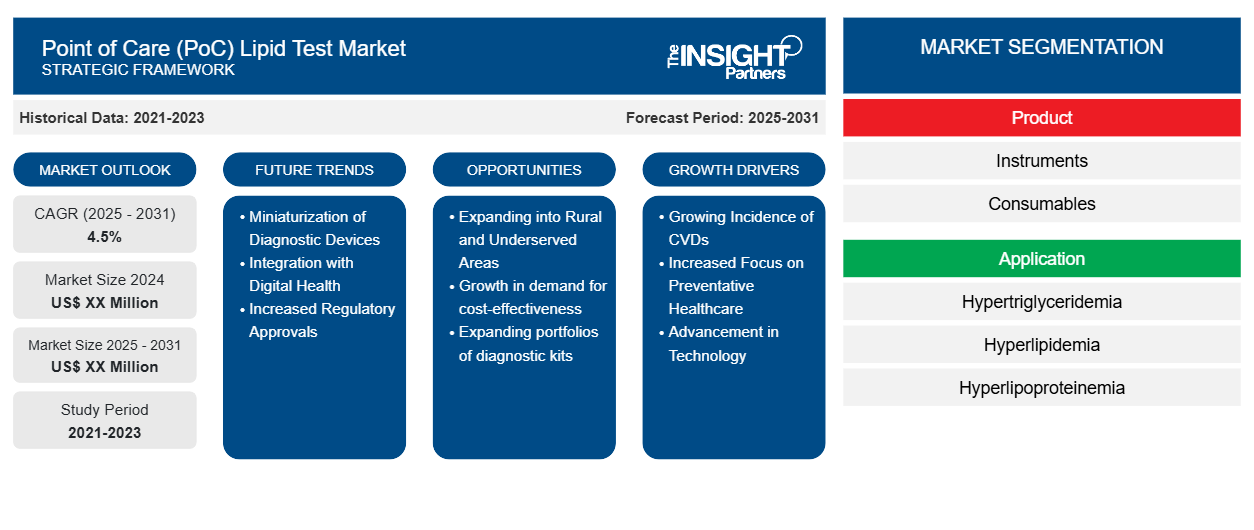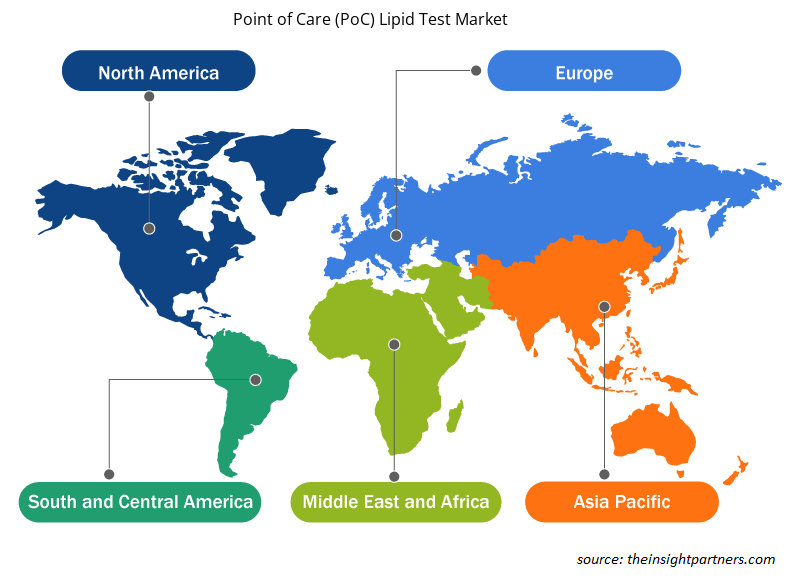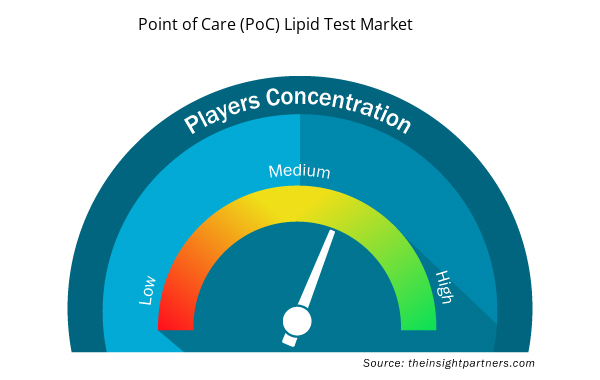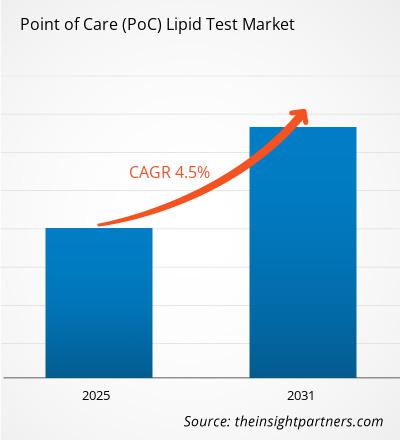The Point of Care (PoC) Lipid Test Market is expected to register a CAGR of 4.5% from 2025 to 2031, with a market size expanding from US$ XX Million in 2024 to US$ XX Million by 2031.
The research report is categorized by product type into the following subsegments: Devices and Consumables. It further presents an analysis based on test type, including Total Cholesterol Tests, Triglyceride Tests, LDL Tests, HDL Tests, and Combined Lipid Panel Tests. Additionally, The report evaluates end-users such as Hospitals, Clinics, Diagnostic Laboratories, and Homecare Settings.
The global analysis is broken down at the regional level and major countries, covering key regions like North America, Europe, Asia Pacific, the Middle East & Africa, and South America. The market evaluation is presented in US$ for the above segmental analysis.
Purpose of the Report
The report Point of Care (PoC) Lipid Test Market by The Insight Partners aims to describe the present landscape and future growth, top driving factors, challenges, and opportunities. This will provide insights to various business stakeholders, such as:
- Technology Providers/Manufacturers: To understand the evolving market dynamics and know the potential growth opportunities, enabling them to make informed strategic decisions.
- Investors: To conduct a comprehensive trend analysis regarding the market growth rate, market financial projections, and opportunities that exist across the value chain.
- Regulatory bodies: To regulate policies and police activities in the market with the aim of minimizing abuse, preserving investor trust and confidence, and upholding the integrity and stability of the market.
Point of Care (PoC) Lipid Test Market Segmentation
Product
- Instruments
- Consumables
Application
- Hypertriglyceridemia
- Hyperlipidemia
- Hyperlipoproteinemia
- Familial Hypercholesterolemia
- Tangier Disease
End User
- Hospitals
- Research and Diagnostic Laboratories
Customize This Report To Suit Your Requirement
You will get customization on any report - free of charge - including parts of this report, or country-level analysis, Excel Data pack, as well as avail great offers and discounts for start-ups & universities
Point of Care (PoC) Lipid Test Market: Strategic Insights

- Get Top Key Market Trends of this report.This FREE sample will include data analysis, ranging from market trends to estimates and forecasts.
Point of Care (PoC) Lipid Test Market Growth Drivers
- Growing Incidence of CVDs: The fastest-growing category for the expansion of the Chromatography Resin Point of Care (PoC) Lipid Test Market is the rising incidence of cardiovascular diseases (CVDs). According to World Health Federation, CVD was the leading cause of death globally in 2021 with 4 in every 5 deaths caused by CVD occurring in low-and-middle-income countries. The most common CVDs are heart disease, stroke, and hypertension, which are also the leading causes of death around the world. According to the WHO, CVDs account for 31% of deaths globally; therefore, preventive measures and early detection become important considerations in healthcare. Lipid profiling, which consists of cholesterol profiles, is crucial for determining CVD risk factors. Rapid detection and monitoring of lipid levels are crucial for the early diagnosis and treatment of conditions. The Point-of-care testing devices offer the benefit of rapid results without the need for patients to visit laboratories or wait for lengthy processing times. Lipid testing has become a convenient and essential tool in the fight against heart disease, especially in regions with a high burden of lifestyle-related CVDs.
- Increased Focus on Preventative Healthcare: According to the Office of Disease Prevention and Health Promotion, prevention is still the best medicine. In recent years, there has been a trend towards preventative healthcare, with a greater focus on early detection and proactive management of health conditions. As people are becoming more health-conscious and avoid the costs and complications associated with chronic diseases, there is an increased demand for regular health monitoring, including lipid testing. Cholesterol-related heart disease has become so pervasive that people are paying attention to lipid levels in hopes of preventing the occurrence of diseases like atherosclerosis, hypertension, and heart attacks. The PoC lipid test in itself becomes perfectly aligned with this preventive care focus since it lets a person follow up on their cholesterol levels regularly and make necessary lifestyle or prescription changes.
- Advancement in Technology: The market for point-of-care testing (PoC) has developed very well, particularly concerning technologies allowing rapid analysis. This means the possibility of lipid testing can be achieved through PoC devices directly at the point of care, which might be located in a physician's office, pharmacy, or even at home. Moreover, it does not require patients to go to the laboratory. POC devices provide healthcare professionals with the ability to perform tests and obtain clear results. This saves money on healthcare services and promotes better patient compliance by allowing early intervention. Advances in PoC lipid testing technology include enhanced sensitivity, specificity, and accuracy. The fact that the PoC devices are portable, user-friendly, and provide results instantly is further helping to drive adoption among both healthcare providers and patients. The trend of reducing hospital visits, especially in the recent times of COVID-19, triggers enhanced demand for PoC lipid tests. As these devices become more advanced, affordable, and accessible, their use in the clinical and home setting is bound to experience significant growth.
Point of Care (PoC) Lipid Test Market Future Trends
- Miniaturization of Diagnostic Devices: One of the commanding trends in the PoC lipid testing market is the miniaturization of diagnostic devices. Miniaturized devices are preferred more as they are Compact, portable, user-friendly, and reasonably priced. These machines have made access to performing a lipid test out of a traditional laboratory setting much easier than ever. Miniature devices have particularly become appealing because professionals outside of direct medical care can use them. These professionals prefer smaller and simple-to-use tools that require no minimal training. The trend toward miniaturization is driven by advances in microelectronics, sensors, and fluid handling technologies, which allow for the integration of sophisticated diagnostic capabilities into small, handheld devices. This trend is very important because it extends access to lipid testing to people who cannot reach traditional health facilities, especially in rural or remote areas.
- Integration with Digital Health: As digital health technologies continue to evolve, the integration of PoC lipid testing devices with digital platforms is an important trend.
This trend towards the implementation of PoC technologies includes devices equipped with Bluetooth, smartphones, and cloud systems for connectivity. Using these technologies will allow users to track their results over time share information with healthcare professionals and access personalized recommendations for improvement connected to their own lipid profile. This trend corresponds to the more general push towards digital health; data from wearable devices, home-testing kits, and other health technologies are increasingly deployed in monitoring chronic conditions remotely. To healthcare practitioners, this means real-time access to patient test data will promote better decision-making, enabling enhanced treatment plans for patients. - Increased Regulatory Approvals: The regulatory environment for PoC testing devices is changing, with many countries revising their policies in support of the approval and commercialization of innovative diagnostic tools. Regulatory bodies such as the U.S.
The FDA, EMA, and others have been increasingly appreciating the value of PoC tests in improving access to health care and enhancing outcomes. In recent years, the approval of PoC lipid test devices has gradually increased, and manufacturers are being made to meet rigorous quality standards and safety requirements. These approvals are an important factor in market growth as they instill confidence in consumers and health care providers.
Point of Care (PoC) Lipid Test Market Opportunities
- Expanding into Rural and Underserved Areas: This is a very significant opportunity for market growth by expanding PoC lipid testing to rural and underserved areas. Many regions, especially in low- and middle-income countries, are not equipped with high-end healthcare infrastructure, including diagnostic laboratories for lipid testing. The PoC device can bridge the gap by offering affordable, portable, and easy-to-use alternatives that can be deployed in remote locations. Mobile health units, pharmacies, and local clinics can be used as points of care for these devices, providing much-needed services to underserved populations. Beyond expanding access to healthcare, PoC lipid tests also provide a cost-effective solution, which is important in areas with limited healthcare budgets. This opportunity is further enhanced by the growing awareness of the importance of lipid testing in the prevention of heart disease and other cardiovascular conditions. By offering these services in rural or underserved areas, companies can tap into a large, untapped market and contribute to improving global health outcomes.
- Growth in demand for cost-effectiveness: In the Asia-Pacific, Latin America, and Africa regions, healthcare demand is growing as incomes rise and populations age. Lifestyle-related diseases, such as hypertension, diabetes, and cardiovascular conditions, are on the rise in these regions, making lipid testing an integral part of healthcare monitoring. PoC lipid testing devices are an ideal solution for these markets as they provide a cost-effective, quick, and reliable means of assessing cholesterol levels without the need for expensive infrastructure. As awareness of the importance of regular lipid testing grows in emerging markets, the demand for PoC devices is expected to increase. This opportunity can be realized by companies entering these markets through offering cost-effective, culture-sensitive PoC lipid testing solutions that cater to local needs, through collaboration with the local government and health organizations, as well as significant distribution networks to facilitate the growth of these technologies in emerging markets.
- Expanding portfolios of diagnostic kits: Multi-disease testing kit opportunities can be found by companies operating in the PoC testing market. These kits may also integrate lipid testing with other key health checks, for example, on blood glucose or inflammation markers. With this combination, one measures various health indicators all at once, which is useful for people prone to cardiovascular disease, diabetes, and related metabolic conditions. Package tests under different products enables companies to present greater value compared to the individual test, likely prompting consumers to buy comprehensive health monitoring solutions. These all-in-one test kits can appeal also to health care professionals looking to add to their point of care holistic screen services. Growing portfolios of diagnostic tests also afford companies the chance to enter a new market with increased market shares through the opportunity to meet many different consumer needs.
Point of Care (PoC) Lipid Test Market Regional Insights
The regional trends and factors influencing the Point of Care (PoC) Lipid Test Market throughout the forecast period have been thoroughly explained by the analysts at Insight Partners. This section also discusses Point of Care (PoC) Lipid Test Market segments and geography across North America, Europe, Asia Pacific, Middle East and Africa, and South and Central America.

- Get the Regional Specific Data for Point of Care (PoC) Lipid Test Market
Point of Care (PoC) Lipid Test Market Report Scope
| Report Attribute | Details |
|---|---|
| Market size in 2024 | US$ XX Million |
| Market Size by 2031 | US$ XX Million |
| Global CAGR (2025 - 2031) | 4.5% |
| Historical Data | 2021-2023 |
| Forecast period | 2025-2031 |
| Segments Covered |
By Product
|
| Regions and Countries Covered | North America
|
| Market leaders and key company profiles |
Point of Care (PoC) Lipid Test Market Players Density: Understanding Its Impact on Business Dynamics
The Point of Care (PoC) Lipid Test Market market is growing rapidly, driven by increasing end-user demand due to factors such as evolving consumer preferences, technological advancements, and greater awareness of the product's benefits. As demand rises, businesses are expanding their offerings, innovating to meet consumer needs, and capitalizing on emerging trends, which further fuels market growth.
Market players density refers to the distribution of firms or companies operating within a particular market or industry. It indicates how many competitors (market players) are present in a given market space relative to its size or total market value.
Major Companies operating in the Point of Care (PoC) Lipid Test Market are:
- F. Hoffmann-La Roche Ltd
- Abbott
- Abaxis
- iXensor
- PTS Diagnostics
- ACON Laboratories, Inc
Disclaimer: The companies listed above are not ranked in any particular order.

- Get the Point of Care (PoC) Lipid Test Market top key players overview
Key Selling Points
- Comprehensive Coverage: The report comprehensively covers the analysis of products, services, types, and end users of the Point of Care (PoC) Lipid Test Market, providing a holistic landscape.
- Expert Analysis: The report is compiled based on the in-depth understanding of industry experts and analysts.
- Up-to-date Information: The report assures business relevance due to its coverage of recent information and data trends.
- Customization Options: This report can be customized to cater to specific client requirements and suit the business strategies aptly.
The research report on the Point of Care (PoC) Lipid Test Market can, therefore, help spearhead the trail of decoding and understanding the industry scenario and growth prospects. Although there can be a few valid concerns, the overall benefits of this report tend to outweigh the disadvantages.
- Historical Analysis (2 Years), Base Year, Forecast (7 Years) with CAGR
- PEST and SWOT Analysis
- Market Size Value / Volume - Global, Regional, Country
- Industry and Competitive Landscape
- Excel Dataset



Report Coverage
Revenue forecast, Company Analysis, Industry landscape, Growth factors, and Trends

Segment Covered
This text is related
to segments covered.

Regional Scope
North America, Europe, Asia Pacific, Middle East & Africa, South & Central America

Country Scope
This text is related
to country scope.
Frequently Asked Questions
The Chromatography Resin Point of Care (PoC) Lipid Test Market is expected to register a CAGR of 4.5% from 2025-2031.
The major factors impacting the Chromatography Resin Point of Care (PoC) Lipid Test Market are: Growing incidences of CVD, Preventive Approaches, and Advanced technologies.
Key future trends in the Chromatography Resin Point of Care (PoC) Lipid Test market are - Miniaturization, integration of digital health, and increaseed regulatory approvals
Key companies of Chromatography Resin Point of Care (PoC) Lipid Test market are: F. Hoffmann-La Roche Ltd, Abbott, Abaxis, iXensor, PTS Diagnostics, ACON Laboratories, Inc, A. Menarini Diagnostics s.r.l, EuroMedix Health am Dom GmbH, Bio-Rad Laboratories, Inc, Nova Biomedical
The report can be delivered in PDF/PPT format; we can also share excel dataset based on the request.
Some of the customization options available based on request are additional 3–5 company profiles and country-specific analysis of 3–5 countries of your choice. Customizations are to be requested/discussed before making final order confirmation, as our team would review the same and check the feasibility.
Trends and growth analysis reports related to Life Sciences : READ MORE..
1. F. Hoffmann-La Roche Ltd
2. Abbott
3. Abaxis
4. iXensor
5. PTS Diagnostics
6. ACON Laboratories, Inc
7. A. Menarini Diagnostics s.r.l
8. EuroMedix Health am Dom GmbH
9. Bio-Rad Laboratories, Inc
10. Nova Biomedical

 Get Free Sample For
Get Free Sample For